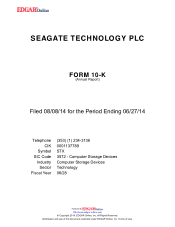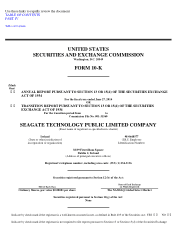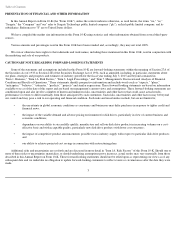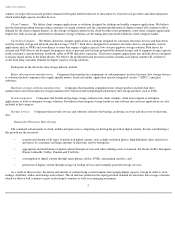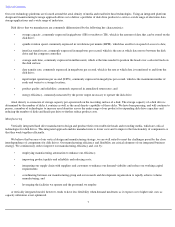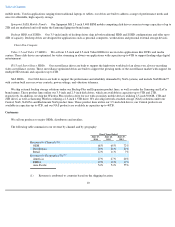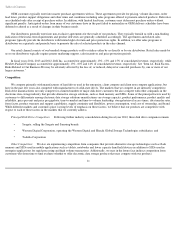Seagate 2013 Annual Report Download - page 9
Download and view the complete annual report
Please find page 9 of the 2013 Seagate annual report below. You can navigate through the pages in the report by either clicking on the pages listed below, or by using the keyword search tool below to find specific information within the annual report.
Table of Contents
The amounts of data created as well as where and how data is stored continues to evolve with the proliferation of mobile devices, the
growth of cloud computing, and the evolving Internet of Things. In addition, the economics of storage infrastructure is also evolving with the
utilization of public and private hyper-scale storage and open-source solutions reducing the total cost of ownership of storage while increasing
the speed and efficiency with which customers can leverage massive computing and storage power. Accordingly, we expect these trends will
continue to create significant demand for electronic data storage solutions.
Demand Trends for Disk Drives
We believe that continued growth in digital content requires increasingly higher storage capacity in order to store, aggregate, host,
distribute, manage, backup and use such content. We also believe that as architectures evolve to serve the growing commercial and consumer
user base throughout the world, the manner which hard drives are delivered to market and utilized by our customers will evolve as well.
We believe that in the foreseeable future the traditional enterprise and client compute markets that require high capacity storage solutions,
as well as the data intensive client non-compute markets, will continue to be best served by hard disk drives due to the industry's ability to
deliver cost effective, reliable and energy efficient mass storage devices. Furthermore, the increased use of client non-compute devices that
consume media-rich digital content streamed from the cloud increases the demand for high capacity disk drives in nearline applications.
Industry Supply Balance
From time to time the industry has experienced periods of imbalance between supply and demand. To the extent that the disk drive industry
builds capacity based on expectations of demand that do not materialize, price erosion may become more pronounced. Conversely, during
periods where demand exceeds supply, price erosion is generally muted.
In early October 2011, floodwaters north of Bangkok, Thailand inundated many manufacturing industrial parks that contained a number of
the factories supporting the HDD industry's supply chain. The HDD industry had concentrated a large portion of its supply chain participants
within these industrial parks in an effort to reduce cost and improve logistics. As a result, the inundation of floodwaters into these industrial
parks had caused the closure or suspension of production by a number of participants within the HDD supply chain.
During the supply chain disruption in fiscal year 2012, we believe demand exceeded supply due to the impact from the flooding in
Thailand, resulting in an increase in the average selling price ("ASP").
The industry's ability to manufacture and ship drives had substantially recovered as of the end of fiscal year 2012. In fiscal years 2013 and
2014, we believe the HDD industry's capacity to manufacture HDDs exceeded demand. However, following the impact of the flooding in
Thailand and further industry consolidation in fiscal year 2012, the HDD industry has maintained improved pricing discipline resulting in benign
price erosion in fiscal years 2013 and 2014.
Our Business
Disk Drive Technology
The design and manufacturing of disk drives depends on highly advanced technology and manufacturing techniques and therefore requires
high levels of research and development spending and capital equipment investments. Manufacturing our disk drives is a complex process that
begins with the production of individual components and ends with a fully assembled disk drive. We design, fabricate and assemble a number of
the most important components found in our disk drives, including read/write heads and recording media. Our design and manufacturing
operations are based on technology platforms that are used to produce various disk drive products that serve multiple data storage applications
and markets.
6

